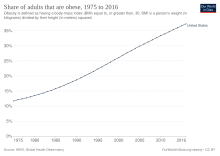**Statistics and Prevalence**:
– In the US, 39.8% of adults were obese in 2015-2016, with 7.6% having severe obesity.
– By 2018, severe obesity among US adults had increased to 9.2%, with total obesity prevalence at 42.4%.
– Severe obesity quadrupled from 1986 to 2000, and extreme obesity increased fivefold.
– Lower income is often associated with a higher risk of obesity.
– Men had an age-adjusted obesity rate of 37.9%, while women had a rate of 41.1%.
**Epidemiology and Effects**:
– Obesity is linked to type II diabetes, cardiovascular disease, cancer, osteoarthritis, and other conditions affecting mortality.
– African American and Mexican American adolescents are more likely to be overweight compared to non-Hispanic White adolescents.
– Obesity contributes to lower life expectancy compared to other high-income countries.
– Obesity may halt the rise in US life expectancy observed in the 19th and 20th centuries.
– Severe obesity can reduce life expectancy by 5 to 20 years.
**Contributing Factors and Causes**:
– Common factors for obesity include overconsumption of food and insufficient physical exercise.
– Diets high in calories, especially from fast food and sugary beverages, are prevalent in the US.
– Socioeconomic factors, genetics, and cultural influences contribute to the obesity epidemic.
– Fast food consumption and high-calorie drinks significantly contribute to the obesity crisis.
– Maternal behaviors during gestation and gut microbiome can influence obesity.
**Race and Ethnicity**:
– Non-Hispanic black adults have the highest prevalence of obesity.
– White adults had an obesity rate of 29.7% in 2015.
– Black adults had an obesity rate of 39.8% in 2015.
– Asian Americans have substantially lower obesity rates compared to other racial or ethnic groups.
– Latino adults had the highest overall obesity rates, reaching 47.0%.
**Dietary Patterns, Fast Food Consumption, and Physical Activity**:
– Most Americans do not follow a healthy dietary pattern.
– 36.6% of US adults consume fast food daily, and 2 out of 3 do so weekly.
– Lack of physical activity due to technology and sedentary lifestyles contributes to obesity.
– In 2020, only 24.2% of US adults met physical activity guidelines.
– American food portion sizes are often double those of British counterparts.
Obesity is common in the United States and is a major health issue associated with numerous diseases, specifically an increased risk of certain types of cancer, coronary artery disease, type 2 diabetes, stroke, and cardiovascular disease, as well as significant increases in early mortality and economic costs.

